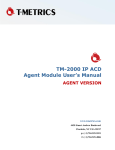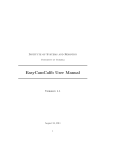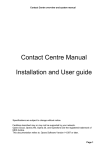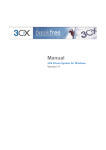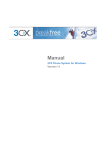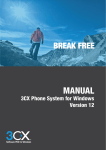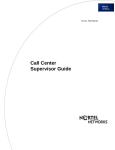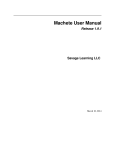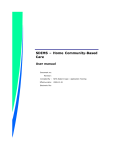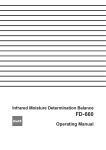Download TM-2000 IP ACD Agent Module v3.0 Supervisor Version
Transcript
TM-2000 IP ACD Agent Module User’s Manual SUPERVISOR VERSION www.tmetrics.com 4430 Stuart Andrew Boulevard Charlotte, NC USA 28217 p: (+1) 704-525-5551 f: (+1) 704-525-4886 e: [email protected] Copyright The information in this document is subject to change without notice. T-Metrics, Inc. assumes no responsibility for any errors or omissions that may appear in this document. TM-2000 and PhoneGroups are trademarks of T-Metrics, Inc. Meridian is a trademark of Nortel. Microsoft, Microsoft Word, Microsoft Access and Microsoft Windows are trademarks of Microsoft Corporation. HASP is a registered trademark of SafeNet, Inc. All materials are Copyright 2008-2012 T-Metrics, Inc. If you have any questions or comments, please contact: T-Metrics, Inc. Customer Service 4430 Stuart Andrew Boulevard Charlotte, North Carolina 28217 USA Phone: +(1) 704.525.5551 Fax: +(1) 704.525.4886 EMail: [email protected] Or visit our Web site at: www.tmetrics.com TM-2000 IP ACD Agent Module User’s Manual SUPERVISOR VERSION March 2012 (03.28) Table of Contents INTRODUCTION ..................................................................................................................................................... 5 ABOUT THE AGENT MODULE ................................................................................................................................. 7 SUMMARY OF ACD AGENT MODULE FEATURES..................................................................................................... 8 AGENT MODULE MENU BAR ...........................................................................................................................................8 STATUS WINDOW ..........................................................................................................................................................9 CALLER ID WINDOW ....................................................................................................................................................10 SKILLS WINDOW ..........................................................................................................................................................10 AGENT WINDOW .........................................................................................................................................................10 MESSAGING BUTTON ...................................................................................................................................................11 EXPANDED VIEW BUTTON .............................................................................................................................................11 EMERGENCY BUTTON ...................................................................................................................................................11 REVIEW OF THE GRAPHICAL USER INTERFACE ..................................................................................................... 12 COLOR CODING ...........................................................................................................................................................12 STATUS WINDOW ........................................................................................................................................................13 STATUS CHANGES ........................................................................................................................................................14 CALLER ID WINDOW ....................................................................................................................................................16 SKILLSETS WINDOW .....................................................................................................................................................16 AGENT STATUS WINDOW ..............................................................................................................................................17 MESSAGING................................................................................................................................................................18 EMERGENCY BUTTON ...................................................................................................................................................20 EXPANDED VIEW SCREEN ..............................................................................................................................................20 AGENT / CHANGE STATUS .............................................................................................................................................23 AGENT / MONITOR ......................................................................................................................................................24 AGENT / SEND MESSAGE ..............................................................................................................................................24 SKILL/SHOW AGENTS LOGGED INTO SKILL ........................................................................................................................24 SKILL/SHOW ALL AGENTS WITH SKILL .............................................................................................................................24 SKILL/SEND MESSAGE ..................................................................................................................................................25 MENU BAR - FILE .................................................................................................................................................. 25 SERVER MESSAGES.......................................................................................................................................................25 SHOW ACTIVITY ITEMS ..................................................................................................................................................25 SHOW EXPANDED VIEW ................................................................................................................................................25 SHOW PAST CALLER IDS................................................................................................................................................25 SHOW PREVIOUS CALLBACK MESSAGES............................................................................................................................25 SOUND RECORDER .......................................................................................................................................................25 EXIT ..........................................................................................................................................................................25 MENU BAR - EDIT ................................................................................................................................................. 26 AGENT CALLBACKS .......................................................................................................................................................26 SETTINGS MENU..........................................................................................................................................................27 TOGGLE SKILLS ............................................................................................................................................................33 MENU BAR - SKILL ................................................................................................................................................ 34 LOGOUT ALL AGENTS IN SKILL ........................................................................................................................................34 SHOW ALL AGENTS WITH SKILL ......................................................................................................................................34 SEND INSTANT MESSAGE...............................................................................................................................................35 MENU BAR - MESSAGES ....................................................................................................................................... 35 T-Metrics, Inc. TM-2000 IP ACD Agent Module User’s Manual SUPERVISOR VERSION 3 RETRIEVE A CUSTOMER MESSAGE ...................................................................................................................................35 COMPLETING THE CUSTOMER MESSAGE INFORMATION.......................................................................................................36 CLOSING THE CUSTOMER MESSAGE WINDOW WITHOUT CALL RESOLUTION SELECTED ..............................................................37 MENU BAR - INFORMATION ................................................................................................................................ 38 SHOW INFORMATION DIRECTORY....................................................................................................................................38 HELP MENU ......................................................................................................................................................... 39 CHECK FOR UPDATES ....................................................................................................................................................39 SEND TROUBLE REPORT ................................................................................................................................................39 AGENT MODULE QUICK REFERENCE GUIDE.......................................................................................................................40 AGENT MODULE SUPERVISOR GUIDE ...............................................................................................................................40 AGENT MODULE USER GUIDE ........................................................................................................................................40 TM-2000 REPORTS PACKAGE GUIDE ..............................................................................................................................40 REMOTE CONNECTION AND REMOTE CONNECTION CUSTOM ...............................................................................................40 ABOUT AGENT MODULE ...............................................................................................................................................40 T-METRICS CUSTOMIZABLE SCREEN POP INTERFACES ......................................................................................... 41 AGENT MINITAP .................................................................................................................................................. 41 OPTIONAL FEATURES ........................................................................................................................................... 41 MESSAGES .................................................................................................................................................................42 COMPLETING THE CUSTOMER MESSAGE INFORMATION.......................................................................................................43 CLOSING THE CUSTOMER MESSAGE WINDOW WITHOUT CALL RESOLUTION SELECTED ..............................................................43 AGENT MESSAGING .....................................................................................................................................................43 CHAT FUNCTION ..........................................................................................................................................................44 T-METRICS EMAILER ....................................................................................................................................................47 T-Metrics, Inc. TM-2000 IP ACD Agent Module User’s Manual SUPERVISOR VERSION 4 Introduction The TM-2000 ACD / Call Center is designed to be the primary point of contact an organization has with its callers, providing a quick and efficient method to obtain the person in the organization who is most qualified to handle callers’ needs. Its integral parts include: Agents (representatives who answer the calls) Supervisors (people who view Agent and Queue statistics) Administrators (people who control call flow and manage the call center) Hardware and software to distribute calls to the appropriate Agents The Agents use a PC to make themselves “Available”, make inquiries and look up information for the caller. The selection of an Agent to receive a call is based on: Agent availability (Status set to “Available”) Phone state (phone is on hook) The Agent’s skill set (ability) and preference level The amount of time the Agent’s phone has been idle (on hook) When Agents become available to take calls (by logging in and selecting “Available”), they are marked as “Available” Agents for each of their skill-set assignments. The goal of the TM-2000 ACD solution is to immediately connect each caller to the most appropriate resource or provide an interactive queue for callers when those resources are busy. They may also exit the queue and, upon returning to a menu, select among various options like: Listen to an announcement Transfer to an extension Leave a message with callback information and hang up In order for the TM-2000 IP ACD to effectively route calls and provide the fastest response to the callers, it is critical that the Agent positions are available to receive the calls. The TM-2000 IP ACD Call Completion Call Center is made up of a number of IP-based modules that have very specific tasks. These include: Event Server Module ACD Controller Module Hardware Interface Module (one or more) Agent Module Agent SoftPhone Module Agent Console Module Reporting Module T-Metrics, Inc. TM-2000 IP ACD Agent Module User’s Manual SUPERVISOR VERSION 5 This manual discusses the use of one of these modules, the ACD Agent Module, which is used by the Agent to log on and off the ACD system. It also discusses the use of this module by a Supervisor. T-Metrics, Inc. TM-2000 IP ACD Agent Module User’s Manual SUPERVISOR VERSION 6 About the Agent Module The ACD Agent Module will automatically configure itself based on the user’s logon name. When the Agent Module logs onto the ACD Controller Module, the logon name is tested to see the job classification of the person logging on. If the person who logs on is an Agent, then certain functions will be turned off or made inaccessible. If the person who logs on is a Supervisor, then certain functions not available to regular agents will be activated. Shown below is the Main Screen of the ACD Agent Module in the Supervisor mode: Figure 1. ACD Agent Module Main Screen in Supervisor Mode T-Metrics, Inc. TM-2000 IP ACD Agent Module User’s Manual SUPERVISOR VERSION 7 Summary of ACD Agent Module Features The following is a summary of the features of the ACD Agent Module. Each feature is detailed later in this manual. Agent Module Menu Bar File o o o o o o o Edit o o o o Server Messages – This option is used to view the messages being sent between the client and server, including timestamps and messages stored from the messaging feature explained later Show Activity Items - This option allows the agent to view all the activity items that they are to choose from at the end of each call Show Expanded View - This opens the expanded view of the Agent Module Show Past Caller IDs – This option is used to view caller ID stamps from earlier in the day, as opposed to the one currently showing in the Caller ID window Show Previous Callback Messages – This option allows for the retrieval of past Customer Callback Messages Sound Recorder – This option is used to create and review sound files for greeting files Exit – Closes the Agent Module and logs the Agent/Supervisor off the ACD system Agent Callbacks – Used to enter a reminder message to be displayed to the Agent in the white display list box in the right window pane when the caller calls back. The “Request Callback Account Number” button will display a Callback Account Code Number for the Agent to give to the caller along with callback number instructions so that the caller can be connected to the same Agent without having to go back into queue when calling back Hours of Operation – Allows the supervisor to modify Hours of Operation from the Agent Software Settings – A list of editable settings for the ACD Agent Module Request Line to Record – Allows the supervisor to choose a server phone line to dial into and record or change menu prompts Agent o o o T-Metrics, Inc. Change Status – Allows the Supervisor to remotely change the Status of an Agent Edit Names and Skills – Allows the Supervisor to modify or add Agents and the Skills associated with particular Agents Monitor… - Once an Agent has been selected, a Supervisor can choose to Listen, Listen -- Barge In, or View. Listen allows a Supervisor to monitor a call in progress, Listen – Barge In allows a Supervisor to step into a call and speak directly with the caller, and View allows a Supervisor to view an Agent’s screen TM-2000 IP ACD Agent Module User’s Manual SUPERVISOR VERSION 8 o o Request Trouble Report – Once an Agent has been selected, a Supervisor can send a Trouble Report from an Agent’s computer Send Instant Message … – Allows the Supervisor to send a private instant text message to a particular Agent or to send a broadcast instant text message to all Agents Skill Edit Activity Items – Once a queue has been selected, a Supervisor is able to add, remove, or modify Activity Items for that Queue o Edit Routing Table – Allows the Supervisor to modify the Routing Table o Logout All Agents in Skill – Will log out all Agents who have a particular skill that is selected in the Skills window o Show Agents With Skill – Shows all agents that have this skill assigned to them, whether they are logged in or not o Send Instant Message - Allows the Supervisor to send a private instant text message to a particular Skillset or to send a broadcast instant text message to all Skillsets Messages (Only appears when you have messages) o Retrieve a Customer Message – This option allows the supervisor to retrieve customer messages from a skill. The Messages menu is only visible when a Customer Message has been left for a skill Information o Informer <F11> – Displays the Information Directory screen Help o Check for Updates – Checks to see if the version is the most current version available on the T-Metrics Support web site o Send Trouble Report – Allows the Supervisor to make history files of the transactions that have been taking place on the Agent Module and the Event Server o Agent Module Quick Reference Guide – Will open a PDF version of the Agent Module Quick Reference Guide o Agent Module Supervisor Guide – Will open a PDF version of the Agent Module Supervisor Guide o Agent Module User Guide – Will open a PDF version of the Agent Module User Guide o TM-2000 Report Package Guide – Will open a PDF version of the TM-2000 Report Package Guide o Remote Connection (and Remote Connection Custom) – Allows T-Metrics Support Staff to connect directly to your PC and solve problems that cannot be handled over the phone or by e-mail o About Agent Module – Displays information about the ACD Agent Module o Status Window Status drop-down menu: o This allows the selection of the Status of the person at the Agent position. With the exception of the required “Logged Off” and “Available” Status T-Metrics, Inc. TM-2000 IP ACD Agent Module User’s Manual SUPERVISOR VERSION 9 items, the rest of the settings are chosen by the system administrator and are stored in a settings table on the TM-2000 server. Typical additional settings are “Performing Post Duties” and “Out to Lunch”. An Agent can only receive an ACD call if he/she is in the “Available” Status and the phone is on-hook (idle). Note: If an “Available” agent takes a call (off-hook state), the Status will change to a blue “Available” Change button o Click this button to activate the Status selected above Caller ID Window Display area shows the following information: o Caller ID or caller-inputted data o Hold Time of the current call o Skill set of current call Skills Window In Queue – This displays the number of calls in queue for all Skillsets. Messages – This displays the number of voicemails for all Skillsets. Skill This column displays all of the skills that the user is a part of; so if a user is a supervisor over three Skillsets, they will all be displayed in this list Avail (Available) o This column displays the number of agents who are currently in an available Status for each skill. This includes both “Available” and “Available” Rqd (Required) o This column displays the number of Agents T-Metrics recommends for an optimal staffing level based on your recent call volume, using the Erlang C calculation Ready o This column displays the number of agents who are currently in an available Status for each skill and are not currently off-hook. This includes only “Available” In Q (In Queue) o This field displays the number of calls in the queue for a particular skill Msgs (Messages) o This field shows the number of messages that are waiting for operators in each of the Skillsets Filter o This checkbox allows the supervisor to filter by skill which agents are displayed in the Agent Window o Agent Window T-Metrics, Inc. TM-2000 IP ACD Agent Module User’s Manual SUPERVISOR VERSION 10 Available – This displays the number of agents in all skills (unless filtered) who are in an available Status, on or off hook. This includes both “Available” and “Available” Logged In – This displays the number of agents that are currently logged into the ACD with at least one common skill to the Supervisor Agent o Task o This column displays a more specific description of what an Agent is currently involved in. It can display Ready, Unavailable, ACD Call, NonACD Call In, NonACD Call Out, and Callback State o This column displays all of the agents which are available to give real time statistics based on the filters checked in the Skills Window This column can display an icon and/or text of the current phone state. It can display Idle, On Call, Ringing, and Hold Status o This column displays the Status in which the agent is currently engaged Messaging Button When an Agent presses the Messaging button, an instant text message box will pop up that the Agent can complete and send to his/her Supervisor. The Supervisor can then respond by sending an instant text message back to the Agent. This process also works vice-versa. Expanded View Button For Agents, this provides a full screen view of the Queue Status; for Supervisors, this provides a full screen view of both the Queue Status and Agent Status information and allows the Supervisor to perform certain functions using the menu items. The extra Expanded View column names are listed below: o Agent , Ext, Skill, Task, State, Status, Time, State, ACD Calls, ACD Avg, Non-ACD, Non-ACD Avg, Emails, ACD Caller ID \ o These will be explained in the Expanded View Screen Section below Emergency Button When an Agent presses the Emergency button, a message is displayed on the Supervisor’s screen in bold red, informing the Supervisor(s) of an emergency situation at the Agent’s position. T-Metrics, Inc. TM-2000 IP ACD Agent Module User’s Manual SUPERVISOR VERSION 11 Review of the Graphical User Interface The next few sections will focus on the different parts of the main screen and the functionality thereof. Subsequently discussion will focus on the menus and their uses. Color Coding There are several color coded signals that can be used to easily ascertain information on the TMetrics ACD Agent Module. For example when an agent’s line is being used (whether the phone is ringing, a caller is on the line, or a caller is on hold) the Status indicator will change from a green Available to a blue Available . Figure 2. ACD Agent Module showing Color Coding Another indicator that will change colors, depending on the information it is displaying, is the number of agents available for each skill (discussed later in the Skillsets section). In the screenshots above, notice that the number of agents available in the “Holiday Support” skillset is “7”, while the numbers displaying how many agents are available in the “Demonstration2” and “TM_IVR” skillsets are “1” and “0” respectively. When the agent detects that there is only 1 agent available in a skill it will display the number 1 with two asterisks to the right and it will display in the color Gold. When there are no agents available in a skill, the agent will display a T-Metrics, Inc. TM-2000 IP ACD Agent Module User’s Manual SUPERVISOR VERSION 12 “0” with two asterisks and it will display in Red. More information about these features is available in the Status Window and Skillsets Window sections. Status Window Shown below is the Status that automatically comes up when the Agent Module is opened. In this Status, the user will not receive calls. Figure 3. Main Screen – Status To log on, simply press the Log On button if your logon name was already entered automatically by the system (see above). If your name was not already entered, then enter your logon name and then press the Log On button. The Agent Module detects whether the user is an Agent or Supervisor by the logon name. When an Agent logs on they are placed in the “Available” Status, ready to receive ACD calls. T-Metrics, Inc. TM-2000 IP ACD Agent Module User’s Manual SUPERVISOR VERSION 13 When a Supervisor logs on they are placed in the first “unavailable” status listed – in this case, “Initial Logon” Status. If Supervisors wish to receive ACD calls, then they would have to change the Status to “Available” using the method described on the next page. Figure 4. Agent in the Initial Logon and Available Status Status Changes The Status drop-down menu allows the selection of a status item. With the exception of the required “Logged Off” and “Available” Status items, the rest of the settings are chosen by the system administrator and stored in the ACD Controller database. Typical additional settings are “Performing Post Duties” and “Out to Lunch”. These settings will make the user “unavailable” to take calls. A user can only receive an ACD call if he/she is in the “Available” Status and the phone is on-hook (idle). Note: If an “Available” agent takes a call (off-hook state), the Status will change to a blue “Available”. (See below section labeled “Color Coding”.) To change the Status, place the mouse over the drop-down menu in the Status Window and click to show all existing Status options. Move the mouse pointer over the appropriate Status T-Metrics, Inc. TM-2000 IP ACD Agent Module User’s Manual SUPERVISOR VERSION 14 and click. The selected Status will then be the only one showing. Click on the Change button to complete the process. Figure 5. Changing Status from Available to Out to Lunch If an Agent is not going to be available to take ACD calls, then it is important for the agent to change their Status to make themselves “unavailable” (e.g., Out to Lunch, On Break, Performing Post Duties) so that calls will not ring at that position. Once the agent is ready to take ACD calls again, simply change the Status back to Available. Note that when an agent is in an “unavailable” state, the Status indicator color changes from green (Status = Available) to yellow (e.g. Status = Performing Post Duties). T-Metrics, Inc. TM-2000 IP ACD Agent Module User’s Manual SUPERVISOR VERSION 15 Caller ID Window This Window shows three pieces of data every time the agent has a call routed to them from the ACD. These data are Caller ID, Time in Queue, and Skillset. Caller ID is the number that the caller is calling from. This may include the trunk number that the 10-Digit Number is a part of. Hold Time is the length of time that the call has been in the system waiting for an answer from an agent. Skillset displays the Skill from which the caller needs assistance and thereby caused the ACD to route the caller to the agent. For instance, if an agent is a member of both Engineering and Sales Skillsets, this indicator will display which of these two skills for which the caller is calling. Figure 6. Caller ID Window Skillsets Window This Skillsets Window provides an easy way to view statistics about all the Skillsets to which the user is connected. The Available column provides the user with how many agents are in the “Available” state for each Skillset listed. The Queue column shows how many callers are in the queue for each Skillset waiting for an available agent. The Msgs (Messages) column shows how many (voice) messages each Skillset has. At the top of the window is a display of the total of calls that are in Queue in the ACD and how many total Customer Messages there are. T-Metrics, Inc. TM-2000 IP ACD Agent Module User’s Manual SUPERVISOR VERSION 16 Figure 7. Skillset Status Window Agent Status Window This window only appears in the Supervisor and Administrator versions of the ACD Agent Module. It is structured similarly to the Skillsets Window. There are three columns just as before. The first column is the Agent field and it displays the name of each individual Agent in all the Skillsets that the Supervisor is a part of. The second column is the Phone field. If icons are turned off in the settings menu, this field will display in text what the state of each agent’s phone is. If icons are turned on, this field will instead show a small picture depicting the same information. The third column is labeled Status and thus shows the Status of each agent. The top portion of the window shows how many agents are logged in, and how many are in the “Available” OR the “Available” Status. It should be noted that this column does not depict how many agents are able to receive calls. To receive a call an agent must be in the “Available” Status i.e. they must have a phone state of “idle” (on hook). This display merely shows how many agents are in any “Available” Status. There may be fewer agents available to take calls. T-Metrics, Inc. TM-2000 IP ACD Agent Module User’s Manual SUPERVISOR VERSION 17 Figure 8. Agent Status Window Messaging The Messaging button is used by an Agent to request a chat session with a Supervisor or vice versa. Pressing this button brings up a form that allows the Agent or Supervisor to enter a text message that is then sent to the other person. The Supervisor can respond and send a text message back to the Agent or vice versa. They can continue sending text messages back and forth until the problem has been resolved. This is very handy when an Agent is working with a caller and wants to ask the Supervisor advice on an issue. The Supervisor is able to help the Agent without going to the Agent’s position or without the caller realizing the Agent is getting help from the Supervisor. A message box appears when a user clicks on the Messaging button. The user can choose to message an individual or broadcast to a skillset. The user chooses the recipient of the message in the top section, then fills out the text area and clicks on the Send button to send the message. The second user (or the entire skillset) receives the message and can write a response back to the first user. T-Metrics, Inc. TM-2000 IP ACD Agent Module User’s Manual SUPERVISOR VERSION 18 Figure 9a. Agent Message Screen Pop Figure9b. Skill Message Screen Pop Figure 9c. Supervisor Message Response Screen Pop T-Metrics, Inc. TM-2000 IP ACD Agent Module User’s Manual SUPERVISOR VERSION 19 Emergency Button Clicking on the Emergency button sends an immediate message to all logged-in Supervisors for any skills assigned to the agent, making him/her aware that a particular Agent is having an emergency condition. Figure 11. Emergency Request Screen Pop Expanded View Screen To open the Expanded View Screen, press this button: To make the information on the ACD Agent Module Main Screen easier to see, the Agent and the Supervisor can click on the Expanded View button. For the Agent, this will display the Queue Status information on a full screen size form. For the Supervisor, this will display the Queue Status information and the Agent Status information on a full screen size form. This form contains many more columns. They are explained here: Skills Window Skill – The name of the skill. Avail – The number of agents with a skill level higher than ‘0’ who are in the available position status. Rqd – The number of Agents T-Metrics recommends for an optimal staffing level based on your recent call volume, using a modification of the Erlang C calculation Ready – The number of agents who are available, not on the phone, and do not have a customer callback waiting for processing on their screen. Level – The viewing agent’s skill level in the skill. In Q (In Queue) – The number of callers in queue for that skill. Oldest - The length of time that the oldest call in queue has been waiting for that skill. Wait Avg - The average length of time that a caller waited in queue before being answered by an agent. The time window used is based on just the last four calls T-Metrics, Inc. TM-2000 IP ACD Agent Module User’s Manual SUPERVISOR VERSION 20 that were in queue. The reason for the deviation for this statistic is to give relevant information for real-time use. (This number can be more volatile to give a better picture of how long people are waiting right now) Msgs – The number of voice messages (customer callbacks) waiting for processing in the queue. Emails – Not in use. Total – The total number of calls that have been assigned to the skill. The time window for this statistic is reset daily at midnight. Ansd – The number of calls within ‘Total Calls’ that were answered by an agent – same time window as Total Calls. Aban (Abandons) – The number of calls within ‘Total Calls’ that were not answered by an agent – same time window as Total Calls. Aban Avg (Abandoned Average) – The average length of time that a caller waits for this skill before abandoning. The time window used is based on just the last four abandoning callers. The reason for the deviation for this statistic is to give relevant information for real-time use. (This number can be more volatile to give a better picture of how long people are waiting before hanging up right now) Aban % (Abandoned Percentage) - The percentage of abandoned calls vs. Total Calls - same time window as Total Calls. ASA (Average Speed of Answer) - The average length of time that a caller waits once assigned to a skill before being answered by an agent. This, along with SLA, is based on a special window of time that is adjustable per skillset to allow for different standards for different skills. SLA (Service Level Agreement) - The percentage of calls that were answered within the period of time as defined in the Controller module for that skill. This, along with ASA, is based on a special window of time that is adjustable per skillset to allow for different standards for different skills. Group – The name of the group that the skill is a part of. If the skill is not a member of a skill group then this column is blank. Email Total - Not in use. Off (Skill is Off) – This checkbox is checked if the skill is turned off for the Agent. Administrators are able to assign this ability, so that an Agent can only turn off/on skills they are allowed to. Filter – This checkbox allows the supervisor to filter by skill which agents are displayed in the Agent Window. Agents Window Agent – This column displays all of the Agents which are available to give real time statistics baed on the filters checked in the Skills Window Ext – The extension for the Agent’s phone Skill – The skill of the last call the Agent took Task– This column displays a more specific description of what an Agent is current involved in. It can display Ready, Unavailable, ACD Call, NonACD Call In, NonACD Call Out, and Callback. State – This column can display and icon and/or text of the current phone state. It can display Idle, On Call¸ Ringing, and Hold. Time – The time that an Agent has been in their current State T-Metrics, Inc. TM-2000 IP ACD Agent Module User’s Manual SUPERVISOR VERSION 21 Status– This column displays the Status in which the agent is currently engaged Time – The time that an Agent has been in the current Status ACD Calls – The number of calls an Agent has taken from the T-Metrics ACD Queue ACD Avg – The average length of ACD Calls in minutes:seconds format Non-ACD – The number of calls an Agent has taken not from the T-Metrics ACD Queue Non-ACD Avg – The average length of NonACD Calls in minutes:seconds format Emails – Not in use ACD Caller ID – The Caller ID for the last call an Agent took from the TMetrics ACD Queue Figure 12. Expanded View T-Metrics, Inc. TM-2000 IP ACD Agent Module User’s Manual SUPERVISOR VERSION 22 Color Coding Status of Agents Logged On and “Available” Logged On and “Available” but on a call Logged On but “Unavailable” (eg. Out to Lunch, etc) Logged Off Figure 13a. Color Coding for the Upper Portion of the Expanded View Color Coding # of Agents Available One (“Caution”: May need more available Agents) Two or more (“Go”: may have enough available Agents) Zero (“Stop”: May need available Agents) Figure 13b. Color Coding for the Lower Portion of the Expanded View Agent / Change Status The Supervisor can change the Status of an Agent simply by highlighting the Agent’s name, choosing Agent / Change Status from the menu bar and then choosing the appropriate Status settings. Alternatively, a Supervisor can right-click on an agent’s name and choose the Change Status” option. For example, if an Agent leaves for lunch still in the “Available” Status, the Supervisor can change the Agent’s Status to “Out to Lunch” without leaving his or her desk. By doing this, the Agent will not receive calls when not available. T-Metrics, Inc. TM-2000 IP ACD Agent Module User’s Manual SUPERVISOR VERSION 23 Figure 14. Changing an Agent’s Status Agent / Monitor NOTE: The Supervisor position must be equipped with the Supervisory Listen & View HASP® key and the Agent must be equipped with a T-Metrics Agent TAP, SoftPhone or PhoneGroups Console to use this feature. With the purchase of the additional hardware and software noted above at the Agent and Supervisor positions, the Supervisor can highlight an Agent’s name and then select Agent / Monitor / Listen to be able to remotely listen to the caller and the Agent. If the Supervisor selects Agent / Monitor / View, the Supervisor will be able to remotely view the Agent’s screen. This feature is very beneficial in training new Agents and monitoring Agents for quality control. Agent / Send Message Allows the Supervisor to send a private instant text message to a particular Agent or to send a broadcast instant text message to all Agents. Skill/Show Agents Logged Into Skill Shows all agents logged in with the selected skill and their Status and skill level. Skill/Show All Agents With Skill Shows all agents that have this skill assigned to them, whether they are logged in or not. T-Metrics, Inc. TM-2000 IP ACD Agent Module User’s Manual SUPERVISOR VERSION 24 Skill/Send Message Allows the Supervisor to send a private instant text message to a particular Skillset or to send a broadcast instant text message to all Skillsets. Menu Bar - File Server Messages This function displays all the messages (communications) between the agent client and the ACD server. Show Activity Items This function displays all the Activity Items of a particular skill, once the logged in user has taken at least one call in that skill. Show Expanded View This functions the same as clicking the Expanded View button at the bottom of the Agent Module. It displays the Expanded View. Show Past Caller IDs This option is used to view caller ID stamps from earlier in the day, as opposed to the one currently showing in the Caller ID window Show Previous Callback Messages This function displays a window with the previous Customer Callbacks. The window will display the File Name, Caller ID, and Call Time of each Customer Callback. A file can be selected and by pressing the Get File button, downloaded to the local computer. Sound Recorder The Play File and Record File options under this menu are used to review and record greeting files. Greeting files are used to give callers an automated message to listen to at the time that an Agent picks up the line. Exit This option closes the ACD Agent Module. T-Metrics, Inc. TM-2000 IP ACD Agent Module User’s Manual SUPERVISOR VERSION 25 Menu Bar - Edit Agent Callbacks The Agent Callbacks Window, shown below, is used when an Agent is working with a caller who will need to call back regarding the same problem. By using this tab selection, the Agent will be able to give the caller callback information, which will allow the caller to be directly connected to the same Agent that has helped before. An Agent must be active, on an ACD call, to use this feature. Figure 15. Agent Callbacks Window The Agent is able to enter a brief message about the call in the rightmost window, such as “John Doe is calling back with the account information for his checking account”; choose the amount of time the callback will be valid from the Callback Account is Valid For list, such as “The remainder of today”; and then click on the Request Callback Account Number button. A Callback Account code will appear for the Agent to give to the caller, along with instructions as to what telephone number to call back. When the call comes back in and is presented back to the Agent, the brief message entered by the Agent will appear in the white display box on the right hand side of the screen. T-Metrics, Inc. TM-2000 IP ACD Agent Module User’s Manual SUPERVISOR VERSION 26 Settings Menu Accessed by selecting Edit > Settings, this window allows the user to change several settings within the ACD Agent Module. The first option in the settings window is the Connections and Miscellaneous Settings menu. Figure 16. Connections and Misc Settings Window Connections and Misc Settings Screen o ProgramName – The program name of this module (This should always read ACDAgent) o Server - The server where events are being sent to o DeskPhone - The desk phone number where calls for this Agent Module will be routed. This phone number needs to be the exact number the incoming trunks must dial to reach this desk phone. Also, this number must exactly match the phone number of the MDN being monitored in a Hardware Interface Module o BlkXtraMsgs – Blocks extra messages from displaying on the Agent tab list box o Order – The order in which this module tries to connect to the server o ExcludeEntry – If checked, excludes using this entry when searching for a server o RetryInterval – If connection to the server fails, this shows the length of time to try and connect again. o LocalPort – The port through which the server communicates with the client o PopWithCall – This option allows the ACD Agent Module to come into focus when a call is received o RecordAllCalls – This option causes all calls to be recorded to a specific directory (Default: C:\Tmetrics\TMIACDAgentModule\CallRecordings) T-Metrics, Inc. TM-2000 IP ACD Agent Module User’s Manual SUPERVISOR VERSION 27 o CannotRedirect – This option, when checked, does not allow the T-Metrics ACD to pull a call back into the system after the RedirectUnansweredCalls timer expires. This feature is used in conjunction with Remote Agents Next in the settings window are the Bubble Forms and System Tray Icon options: Figure 17. Bubble Forms and System Tray Bubble Forms pop up when certain events occur, such as an incoming call or an instant message. From here, the administrator may enable/disable the Bubble Form feature, as well as configure the Bubble Forms’ fade settings. Additionally, the administrator may set the Agent Module to minimize to the System Tray from this menu. Agent Tagging allows a supervisor or administrator to receive alerts when specified agents take specified actions, like changing position or phone states. Next in the settings window is the Data Grid Options screen: T-Metrics, Inc. TM-2000 IP ACD Agent Module User’s Manual SUPERVISOR VERSION 28 Figure 18. Data Grid Options The Data Grid Options menu allows the administrator to customize how information is displayed within the Agent Module. From here, changes may be made to the grid display, concerning grid location, ordering, font, symbols, etc. From this menu, the Administrator may also create a Customized Agent Grid Filter, displaying only specified agents. Next in the settings window is the E-Mail and Trouble Report Settings panel: T-Metrics, Inc. TM-2000 IP ACD Agent Module User’s Manual SUPERVISOR VERSION 29 Figure 19. Email and Trouble Report Settings This menu allows the user to quickly and easily report problems to the T-Metrics support team. From here, the user would fill in their name, as well as their E-Mail Address or phone number – preferably both, though only one is required. The user then selects which email client their PC uses, and an email addressed to the TMetrics support team will automatically open when sending a trouble report. To send a trouble report, select “Send Trouble Report” from the Help menu. Next in the settings window is the Greeting Files Option: Figure 20. Greeting Files Form From this menu, a user may set which greeting file they wish to play at their station for selected skills. o Filename – The filename of the audio file to be used as a greeting o Skill – The skill that is to be used with the greeting file o Phonenumber – The phone number of the user o UserName – The agent’s username T-Metrics, Inc. TM-2000 IP ACD Agent Module User’s Manual SUPERVISOR VERSION 30 Next in the settings windows is Instant Messages panel: Figure 21. Instant Messages From this menu, the user can configure the instant messenger and chat features included in the ACD Agent Module. o Pop Incoming IM’s to the Front -- This option allows incoming Instant Messages to display in the forefront of the user’s screen. It will load on top of any other window that is open o Play Sound for Incoming IM’s -- This option allows an audible sound to play when an instant message is received through the ACD Agent Module o Show Status Changes of Other Agents in Instant Message Windows – This option will display the current status of the agent the user is messaging in the chat window o I Have a Chat Server – its Network Address (or Computer Name) is: -- If a Chat Server is available, it will need to be set via this option. After the Network Address or Computer Name is set, the user will need to restart the Agent Module before they can join or create a chat room T-Metrics, Inc. TM-2000 IP ACD Agent Module User’s Manual SUPERVISOR VERSION 31 Next in the submenu is Sound Devices: Figure 22. Sound Devices This menu allows the user to choose which sound device will be used in conjunction with the ACD Agent Module software. o Play Device – The audio device used for audio playback for the agent o Recording Device – The audio device used to capture call recordings o Listen Device – The audio device used by a supervisor when listening to an agent’s live call T-Metrics, Inc. TM-2000 IP ACD Agent Module User’s Manual SUPERVISOR VERSION 32 Next in the submenus is User Interaction: Figure 23. User Interaction This menu allows the user to make several selections to customize how they will interact with the Agent Module. o Allow Us of Keyboard (Enter Key) to Select Activity Items o Allow Use of Keyboard (Enter Key) to Change Position Status o Show My Current Status Time Next to My Position Status o Minimize the Agent Module to the System Tray o Confirm with User Prior to Sending Emergency Messages o Disable the Emergency Button o Show Status Details Input Box The user may also assign Global Hotkeys to perform common actions via keyboard shortcut. Toggle Skills If an Agent has been given the ability to turn on and off Skills by a Supervisor, this feature will allow the Agent to perform those actions. T-Metrics, Inc. TM-2000 IP ACD Agent Module User’s Manual SUPERVISOR VERSION 33 Menu Bar - Agent The Agent Menu on the Menu Bar is the same as the Agent Menu in the Expanded View. See the Expanded View section for details. Menu Bar - Skill Logout All Agents in Skill This function will logout all agents who have the selected skill. The user is warned before the action takes place. Figure 24. Log Off Warning Message Show All Agents With Skill This option shows all agents that are a part of the selected Skillset. You can use the button in the bottom left corner to display either all agents or just all agents that are logged in. Figure 25. All Agents Logged In With Skill T-Metrics, Inc. TM-2000 IP ACD Agent Module User’s Manual SUPERVISOR VERSION 34 Figure 26. All Agents With Skill Send Instant Message This option launches the Instant Messaging feature allowing the Supervisor to message an entire Skillset. This can also be accomplished by clicking on the Messaging button and then the Skillset radio button. Menu Bar - Messages Retrieve a Customer Message This option is in place to allow a Supervisor to manually retrieve Customer Messages (voice messages) left by a caller for a skill when the Supervisor is in a non-available Status. Conversely, callers can leave a Customer Message that will either be delivered to an “Available” Agent when there are no “live” calls to be presented, or delivered to an agent as if it were a live call with its own place in queue (depending on the way the system is configured). When a Customer Message is sent to an Agent, the Agent is presented with the Customer Message Information window shown below. T-Metrics, Inc. TM-2000 IP ACD Agent Module User’s Manual SUPERVISOR VERSION 35 Figure 27. Customer Message Information Screen Pop In order to listen to the Customer Message, the Agent will click on the Listen To Msg button. The Agent’s desk phone (either a standard phone or a T-Metrics SoftPhone box) will then ring and the Agent will be instructed to “Press any key to play the message”. For Agents using a standard phone set, press any key on the telephone keypad. For Agents using a T-Metrics Console, go to Telephone Tools on the menu bar, select DTMF Send <CTRL+Alt>, and then press any digit on the keyboard. The Agent can press any key to play the message again. Completing the Customer Message Information When the message has finished playing, the Agent must select one of the other buttons on the Customer Message Information window to indicate the action taken in regards to the message: If the Agent reaches the caller and completes the message, the Agent presses the Customer Called button and the window will close. This will mark the call as “Cust Called” in the call records log for reporting purposes. T-Metrics, Inc. TM-2000 IP ACD Agent Module User’s Manual SUPERVISOR VERSION 36 If the Agent is unable to complete the message (e.g., leaves a message for the caller, etc.), the Agent presses the Customer Unavailable button and the window will close. This will mark the message as “Cust Unavailable” in the call records log for reporting purposes. Closing the Customer Message Window without Call Resolution Selected If the Agent closes the Customer Message Information window by selecting the X in the upper right-hand corner, the message will be sent back to the Agent to retrieve again. If the Agent receives an incoming call, the message will be sent to the Agent when the position is “Available”. If the Agent makes his/her position unavailable (by selecting “On Break”, “Out to Lunch”, etc), the message will be routed to the next available Agent. If the Agent closes the Customer Message Information window by pressing the Close with No Action button, the message will be sent back to the Agent to retrieve again. If the Agent receives an incoming call, the message will be sent to the Agent when the position is “Available”. If the Agent makes his/her position unavailable (by selecting “On Break”, “Out to Lunch”, etc), the message will be routed to the next available Agent. NOTE: The Customer Message Information window should not be closed by these methods as it creates reporting errors in the call reconciliation process. T-Metrics, Inc. TM-2000 IP ACD Agent Module User’s Manual SUPERVISOR VERSION 37 Menu Bar - Information Show Information Directory This is used to pop up the Information Directory which is used to access information using a Windows Explorer-type of form. This data can be anything including documents in text and RTF and pictures in such formats as BMP, JPG. Also URL address on the web can be accessed though the viewer. More information can be found in the Informer User Manual. Figure 28. Information Directory T-Metrics, Inc. TM-2000 IP ACD Agent Module User’s Manual SUPERVISOR VERSION 38 Help Menu The Help menu item has five options under it, which are Check for Updates, Send Trouble Report, Agent Module Quick Reference Guide, Agent Module Supervisor Guide, Agent Module User Guide, TM-2000 Reports Package Guide, Remote Connection, Remote Connection – Custom, and About Agent Module. Check for Updates Clicking on this item will cause the PC to look across the network to the T-Metrics Support site to see if there is a software update available. Send Trouble Report In the event that a problem occurs, Send Trouble Report is used by an Agent / Supervisor to trap the most recent activity on the Agent / Supervisor PC and on the ACD Server that will be forwarded to the T-Metrics Support Staff. To make a file that will be sent to T-Metrics, do the following: Click on the Help menu at the top of the screen and select the Send Trouble Report option. The screen below will appear. Figure 29. Trouble Report Dialog Box T-Metrics, Inc. TM-2000 IP ACD Agent Module User’s Manual SUPERVISOR VERSION 39 Follow the on screen instructions and submit the Trouble Report by clicking Send Email to T-Metrics Support, I Will Call T-Metrics, or I Will NOT Contact TMetrics Support. Agent Module Quick Reference Guide This function will open a PDF version of the Agent Module Quick Reference Guide. Agent Module Supervisor Guide This function will open a PDF version of the Agent Module Supervisor Guide. Agent Module User Guide This function will open a PDF version of the Agent Module User Guide. TM-2000 Reports Package Guide This function will open a PDF version of the TM-2000 Report Package Guide. Remote Connection and Remote Connection Custom T-Metrics may request that you use this feature to allow us to remotely control your PC in order to fix an issue. T-Metrics will provide you with instructions on how to use this feature should the need arise. About Agent Module About Agent Module is an about box telling who made the product and the version of it. Figure 30. Agent Module Information Box Showing Version Number T-Metrics, Inc. TM-2000 IP ACD Agent Module User’s Manual SUPERVISOR VERSION 40 T-Metrics Customizable Screen Pop Interfaces T-Metrics has developed Screen Pop Interfaces for several of our customers. In each instance we have worked with the in-house expert from the customer site to develop tools that assist operators in using T-Metrics software in conjunction with their already existing systems. T-Metrics has been able to successfully integrate several clients like CHCS,Remedy Interface, Magic Interface, and Web Client Interface. Working with a customer to create a useful apparatus, T-Metrics has the ability to create software which will work with an existing system. For example, by merging our ACD and a customer service system owned by a customer, it is possible for a customer to enter a customer ticket number while they wait in queue and have the system “pop” a screen to the operator at the appropriate time bringing up their ticket containing all their information. Agent MiniTAP The Agent MiniTAP will allow for agent greetings and recording of telephone calls. It is also required at each Agent position for the Supervisory Listen & View feature, in addition to the HASP key at the Supervisor position. Figure 31. Picture of the T-Metrics Agent MiniTAP Optional Features The T-Metrics Agent module includes several optional features, which may be activated depending on the site’s needs, hardware setup, and purchased services. T-Metrics, Inc. TM-2000 IP ACD Agent Module User’s Manual SUPERVISOR VERSION 41 Messages Retrieve a Customer Message This option is in place to allow an agent to retrieve Customer Messages (voice messages) left by a caller for a skill manually when the system is configured to withhold them until they are requested by an agent. Conversely, the system can be configured so that callers can leave a Customer Message that will either be delivered to an “Available” Agent when there are no “live” calls to be presented, or delivered to an agent as if it were a live call with its own place in queue (depending on the way the system is configured). When a Customer Message is sent to an Agent, the Agent is presented with the Customer Message Information window shown below. Figure 32. Customer Message Information Screen Pop In order to listen to the Customer Message, the Agent will click on the Listen To Msg button. The Agent’s desk phone (either a standard phone or a T-Metrics SoftPhone box) will then ring and the Agent will be instructed to “Press any key to play the message”. For Agents using a standard phone set, press any key on the telephone keypad. T-Metrics, Inc. TM-2000 IP ACD Agent Module User’s Manual SUPERVISOR VERSION 42 For Agents using a T-Metrics Console, go to Telephone Tools on the menu bar, select DTMF Send <CTRL+Alt>, and then press any digit on the keyboard. The Agent can press any key to play the message again. Completing the Customer Message Information When the message has finished playing, the Agent must select one of the other buttons on the Customer Message Information window to indicate the action taken in regards to the message: If the Agent reaches the caller and completes the message, the Agent presses the Customer Called button and the window will close. This will mark the call as “Cust Called” in the call records log for reporting purposes. If the Agent is unable to complete the message (e.g., leaves a message for the caller, etc.), the Agent presses the Customer Unavailable button and the window will close. This will mark the message as “Cust Unavailable” in the call records log for reporting purposes. Closing the Customer Message Window without Call Resolution Selected If the Agent closes the Customer Message Information window by selecting the in the upper right-hand corner, the message will be sent back to the Agent to retrieve again. If the Agent receives an incoming call, the message will be sent to the Agent when the position is “Available”. If the Agent makes his/her position unavailable (by selecting “On Break”, “Out to Lunch”, etc), the message will be routed to the next available Agent. If the Agent closes the Customer Message Information window by pressing the Close with No Action button, the message will be sent back to the Agent to retrieve again. If the Agent receives an incoming call, the message will be sent to the Agent when the position is “Available”. If the Agent makes his/her position unavailable (by selecting “On Break”, “Out to Lunch”, etc), the message will be routed to the next available Agent. NOTE: The Customer Message Information window should not be closed by these methods as it creates reporting errors in the call reconciliation process. Agent Messaging In addition to sending IM messages to Supervisors, Agents may send IMs to one another, if the Administrator has enabled “IM for All” for their skillset on the server. T-Metrics, Inc. TM-2000 IP ACD Agent Module User’s Manual SUPERVISOR VERSION 43 Figure 33. Agent(s) and Skillset Messaging Window When “IM for All” is enabled, the Agent will see two bullet options: Agent(s) and Skillset. Under Agent(s), the Agent may select one or several specified agents to whom they may send an IM message. Under Skillset, the Agent may choose to send an IM to ALL agents and supervisors with a selected skill. Chat Function The T-Metrics system also provides the option to use Chat Rooms. Unlike the IM feature, the Chat Rooms offer agents and supervisor to have a group discussion. If the site is using a chat server, and that server has been set in the ACD Agent Module’s Instant Messaging Settings windows (see page 31), then the Agent will see additional options when clicking on the Messaging key. T-Metrics, Inc. TM-2000 IP ACD Agent Module User’s Manual SUPERVISOR VERSION 44 Figure 34. Messaging Window with Chat Room selection The Agent may select Join a Room, and then select from any of the available public or private rooms currently in operation. T-Metrics, Inc. TM-2000 IP ACD Agent Module User’s Manual SUPERVISOR VERSION 45 . Figure 35. Chat Room Selection If the Agent selects Create a Room, a set-up window will appear, prompting the Agent to provide a Chat Room Name, select whether the room will be moderated or unmoderated, whether the room will be public or private, which agents will be allowed to issue invitations to the chat. The set-up windows also provided the Agent with the option of setting an initial topic for the chat. Figure 36. Chat Room Creation T-Metrics, Inc. TM-2000 IP ACD Agent Module User’s Manual SUPERVISOR VERSION 46 T-Metrics Emailer The T-Metrics Emailer provides the Agent with a singular communications solution. With the TMetrics Emailer working in conjunction with the TM-2000 IP Platform, and the client’s email server, Agents will receive all calls and emails by the same means. Rather than juggling their workload between the Agent Module and a separate email client, Agents will receive email messages from their Agent Module via pop-up window, when they are not taking calls or are otherwise Available. Figure 37. Emailer Window The Emailer Window: Email Information: Provides basic information, such as the “To” and “From” address, carbon copy and blind carbon copy lists, email subject line and attachments. Email: The body of the delivered email. Your Reply: Where the Agent types their response. Attachments: Allows the Agent to add/remove files to their response as attachments. T-Metrics, Inc. TM-2000 IP ACD Agent Module User’s Manual SUPERVISOR VERSION 47 Place Back in Queue: Allows the Agent to place an email message back in queue. When selected, the Agent is given the option of redirecting the email to a specific user. Figure 38. Redirect Window o If the Agent selects Yes, the Agent will choose from a list of logged-in agents, and be given an input form to note the reason why the email is being redirected. Figure 39. Redirect to Agent Window o If the Agent selects No, the Agent will be given an input form to note the reason why the email is being redirected, after which the email will be placed back in T-Metrics, Inc. TM-2000 IP ACD Agent Module User’s Manual SUPERVISOR VERSION 48 queue and delivered to the next Available agent. Figure 40a. Redirect Reason o The Agent who receives the redirected email, will also receive a pop-up with the message the previous agent noted in the input form. Figure 40b. Redirect Reason Spam: Allows the Agent to flag the delivered email as spam. Ignore: If selected, the delivered email will be marked as handled, but a reply is not sent. Address Book: Opens your email program’s address book. (Microsoft Outlook will need to be open and have focus to pop the address book.) Direct Replies Back to Me: When checked, replies to this email chain will be automatically redirected to the agent who handled the message, and not placed in the general queue. Send Reply: Sends the Agent’s response. T-Metrics, Inc. TM-2000 IP ACD Agent Module User’s Manual SUPERVISOR VERSION 49

















































